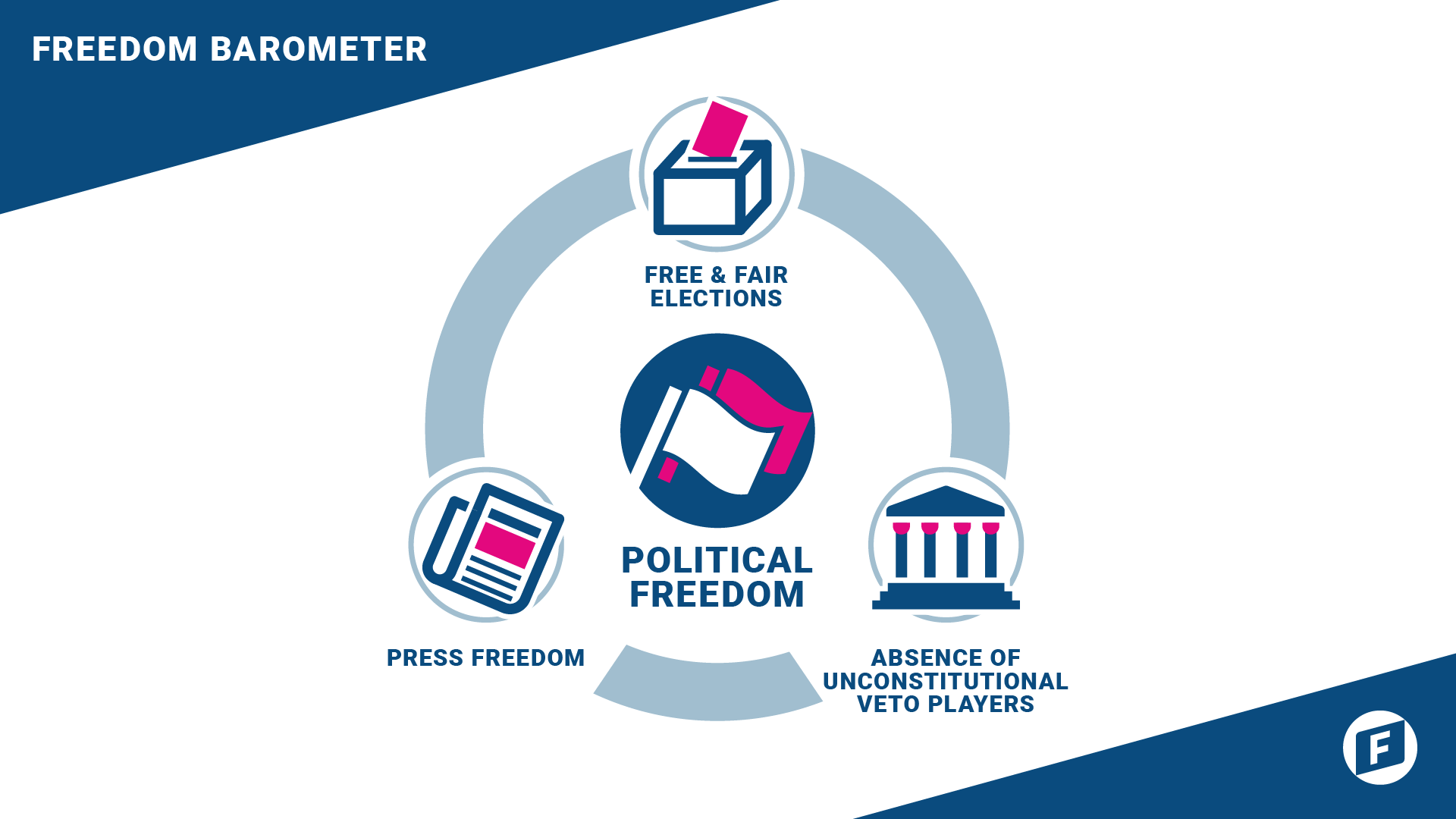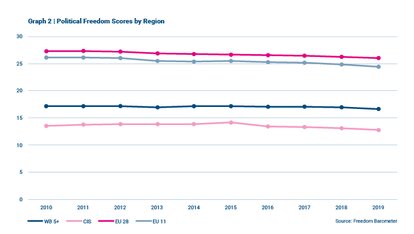Freedom Trends
Political Freedom: 10 Years of Freedom Barometer

Freedom Barometer - Political Freedom Overview
©A decade of measuring freedom by the Freedom Barometer Index was a decade of decline in political freedom. The wave of building, strengthening, and shaping liberal and democratic societies all over Europe, itself started after the fall of the Iron Curtain, was interrupted by an outburst of autocratic tendencies in recent years, causing a deterioration of freedom on the political playground. Though such autocratic beliefs had existed long before, all the time “flirting” with flaws of democracy like a “patient on appliances”, it was the citizens’ accumulated dissatisfaction with democracy and a change in the everyday habits and needs of citizens – mostly of a technological nature or caused by its developments – that made a convenient fracture allowing the re-emergence of autocracy. Some rather conservative and nationalistic political leaders, when they spotted the fracture, didn’t miss this opportunity to advance their position, be it for incumbents to put a tighter grip on governance or for newcomers to climb to power. Using populist and harsh rhetoric in combination with a manipulation of public opinion, they emphasized their citizens’ dissatisfaction with democracy to the degree that even a crackdown on independent democratic institutions and basic human rights became justifiable to some people. They justified it for a “greater cause”.
FREEDOM IN EUROPE BECAME AN ENDANGERED VALUE TO THE LEVEL THAT A CRACKDOWN ON INDEPENDENT DEMOCRATIC INSTITUTIONS AND BASIC HUMAN RIGHTS BECAME JUSTIFIABLE TO MANY PEOPLE.
A first glance at the graph below clearly shows us that Political Freedom, as set by the Freedom Barometer Methodology and all its indicators – Free and Fair Elections; Absence of Unconstitutional Veto Players; and Press Freedom – all fall down by around 0.5 points on a scale of 1 to 10. True, one could argue that this decline was not that big. However, by going more deeply into the methodological background of such data, it is clearly not easy to achieve that – it needs a long term, abrupt, and consistent violation of freedom. To a worrisome degree in certain countries, taken into consideration that some of the world’s most advanced democracies are being monitored here. Throughout the next couple of pages, we will try to provide you with the most important developments in political freedom in Europe.

Political Freedom Indicators
The reason for talking about autocratic tendencies is that all the trends that were determined to cause a decline of political freedom fall under the scope of ‘characteristics of autocratic ruling’, such as the manipulation of public opinion, the capture of state institutions, unequal conditions for different political players, blurred constitutional separation of powers and limitations put on media freedom. The graph presented below provides an oversight of political freedom developments in certain regions, or from another perspective, insight into the level of application, adjustment, and effectiveness of autocratic tendencies in these regions, or even the national realities of the countries in those regions.
THESE POLITICAL FREEDOM GRAPHS ALSO REVEAL THE LEVEL OF APPLICATION, ADJUSTMENT, AND EFFECTIVENESS OF AUTOCRATIC TENDENCIES IN EUROPE.

Political Freedom Scores by Region
Several conclusions could be drafted from it. First, the achieved level of democratic development is directly correlated with the capacity of countries to deal with autocratic challenges. The higher the level of democracy, the bigger the possibility that those negative tendencies will have less impact. Though developed Western democracies have witnessed a strong electoral support for right-wing nationalistic parties and movements, the latter’s strong appearance was buffered by a firm democratic value base that had been built up over many years. One should not be misled by this however, since the popularity of these parties across society in many countries is bigger than ever. Also, freedom has deteriorated less in the least developed democracies, or in countries that already have had autocratic rule. The reason for this could, maybe, be best described by using a common proverb – “but it can’t deteriorate more than it has already”. However, countries like Tajikistan proved that there could always be “more” (i.e., worse), with political freedom in this country hitting the very bottom in 2019. On the other hand, political freedom saw its biggest decline in countries that had recently gone through democratic transition and where democratic values hadn’t been embedded into society, such as in Balkan countries, including – and led by – Turkey, whose answer to a failed coup triggered a series of violations of freedom.
Although slightly more developed, this group includes Central and Eastern European EU-member states. Cases of state control over all branches of power by the ruling party in Poland, the murder of an investigative journalist in Slovakia, and a crackdown on civil society organizations and media in Hungary, are only the tip of the iceberg. So let’s get more detailed by analysing the sub-sections of political freedom.
-
Download the full report!